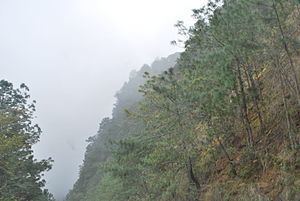Conservation status Critical/endangered Habitat loss 7.6452% Area 65,600 km² Mammal species 169 | Global 200 Yes Protected 9.8% Bird species 336 | |
 | ||
Borders Chihuahuan Desert
Tamaulipan mezquital
Tamaulipan matorral
Veracruz moist forests
Veracruz montane forests
Trans-Mexican Volcanic Belt pine-oak forests
Central Mexican matorral
Meseta Central matorral Countries Mexico (Northeast), and United States (Texas) Biome Tropical and subtropical coniferous forests | ||
The Sierra Madre Oriental pine-oak forests are a subtropical coniferous forest ecoregion of northeastern and Central Mexico, extending into the state of Texas in the United States.
Contents
Setting
The Sierra Madre Oriental pine-oak forests are found at elevations of 1,000–3,500 m (3,300–11,500 ft) above sea level in the Sierra Madre Oriental range, which runs north and south between the Gulf Coastal Plain to the east along the Gulf of Mexico, and the Mexican Plateau to the west. They are also found in the Sierra Norte de Puebla, adjacent to the southern Sierra Madre Oriental. The ecoregion covers an area of 65,600 km2 (25,300 sq mi).
The southernmost forests transition to the Trans-Mexican Volcanic Belt pine-oak forests in central Puebla state, near the southern end of the Sierra Madre Oriental. The forests extend almost continuously along the range through the states of Veracruz, Hidalgo, Querétaro, Guanajuato, San Luis Potosí, Tamaulipas, Nuevo León, and northern Puebla. North of Monterrey, the forests become discontinuous, extending as a series of sky islands through the states of Nuevo León and Coahuila, and on into the Chisos and Davis mountains of the Big Bend region of western Texas. Other sky islands can be found on the higher peaks of the mountain ranges rising from the Mexican Plateau to the west.
Flora
The dominant species are many species of pine including Nelson pinyon (Pinus nelsonii), Mexican pinyon (P. cembroides), smooth-bark Mexican pine (P. pseudostrobus), and Arizona pine (P. arizonica), and the oaks Quercus castanea and Q. affinis. On the wetter slopes facing the ocean the most common trees are Mexican pinyon and Juniperus deppeana, while on the drier western slopes weeping pinyon (Pinus pinceana) is more common. The forests are home to a great variety of other flora including agave and traditional food plants.
Fauna
Mammals that inhabit this ecoregion include the American black bear (Ursus americanus), which migrate along the Rio Grande from northern Coahuila to the Chisos Mountains in Texas, mule deer (Odocoileus hemionus), cougar (Puma concolor), cliff chipmunk (Tamias dorsalis), collared peccary (Pecari tajacu), white-nosed coati (Nasua narica), jaguar (Panthera onca) and coyote (Canis latrans).
The maroon-fronted parrot (Rhynchopsitta terrisi) and Colima warbler (Vermivora crissalis) are endemic to this ecoregion. Wild turkeys (Meleagris gallapavo), peregrine falcons (Falco peregrinus) and golden eagle (Aquila chrysaetos) are also resident.
Pine-oak forests in Coahuila are part of the migration route of monarch butterflies (Danaus plexippus).
